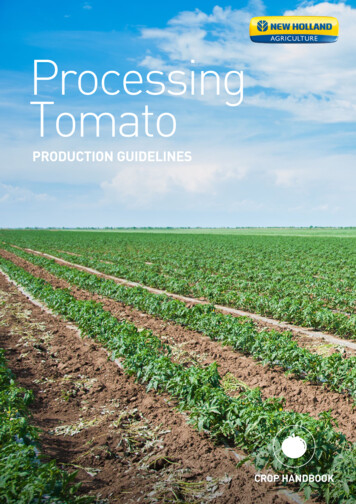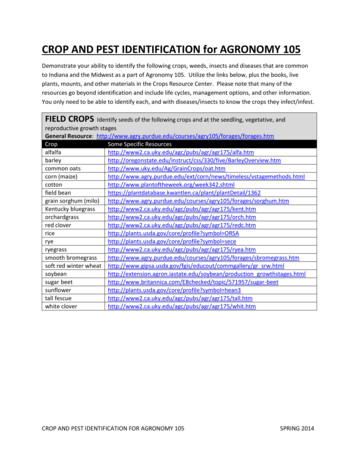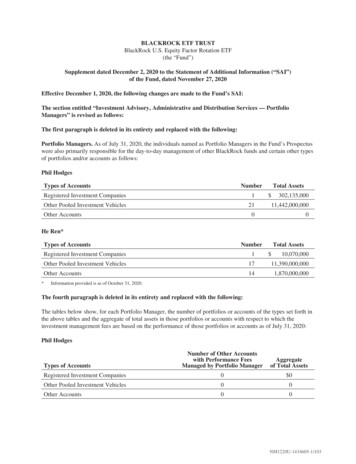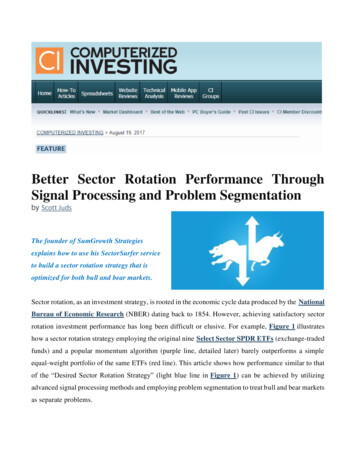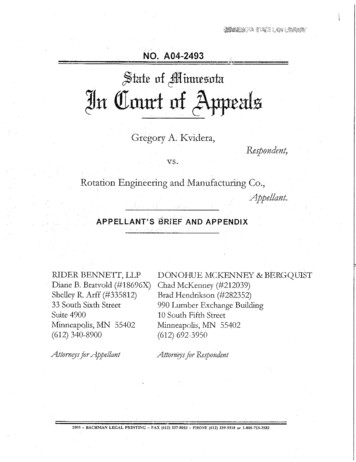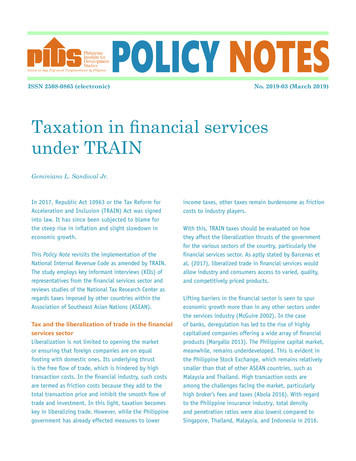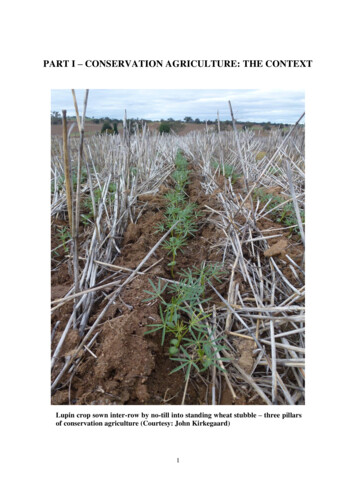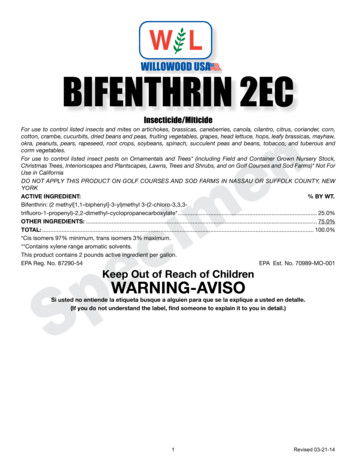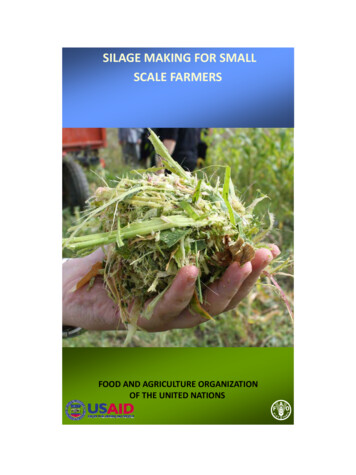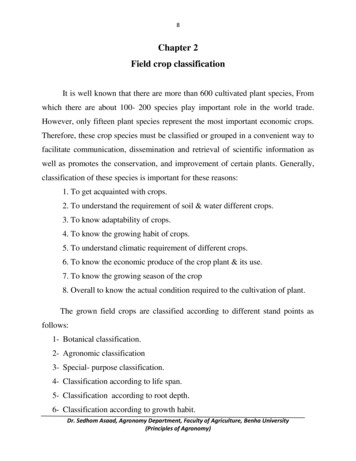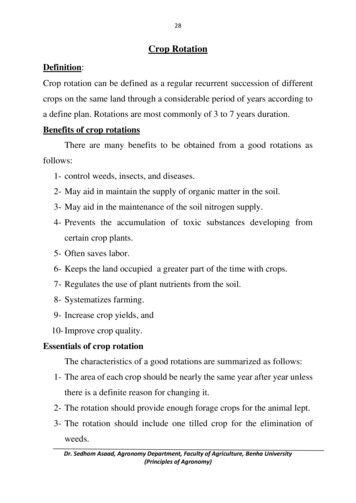
Transcription
28Crop RotationDefinition:Crop rotation can be defined as a regular recurrent succession of differentcrops on the same land through a considerable period of years according toa define plan. Rotations are most commonly of 3 to 7 years duration.Benefits of crop rotationsThere are many benefits to be obtained from a good rotations asfollows:1- control weeds, insects, and diseases.2- May aid in maintain the supply of organic matter in the soil.3- May aid in the maintenance of the soil nitrogen supply.4- Prevents the accumulation of toxic substances developing fromcertain crop plants.5- Often saves labor.6- Keeps the land occupied a greater part of the time with crops.7- Regulates the use of plant nutrients from the soil.8- Systematizes farming.9- Increase crop yields, and10- Improve crop quality.Essentials of crop rotationThe characteristics of a good rotations are summarized as follows:1- The area of each crop should be nearly the same year after year unlessthere is a definite reason for changing it.2- The rotation should provide enough forage crops for the animal lept.3- The rotation should include one tilled crop for the elimination ofweeds.Dr. Sedhom Asaad, Agronomy Department, Faculty of Agriculture, Benha University(Principles of Agronomy)
294- The rotation should keep the organic matter of the soil.5- The rotation should provide as large an area of the most profitablecash crop as can be carried for.6- The rotation should allow an appropriate sowing date for all crops.7- The rotation most profitable crop should be given the best place in therotation.Planning the RotationIn planning the crop rotation, the following steps should beconsidered:1- Selection of rotations crops:2- Determination of the area allotted to each crop3- Determination of the rotation duration4- Determination of the number of fields (sections) in the rotations5- A square form is then drawn and divided into sections equal in theirnumber to that of the rotation fields.6- The selected crops are classified into winter and summer crops, andinto leguminous and non leguminous crops.7- The selected crops are then distributed in the rotation fields, the maincrop should occupy the upper field (section), the second field isoccupied with the crop which is likely to succeed the main crop, andthe other fields are occupied with the other selected crops in the sameorder. The same crop sequence planned in the first year should berepeated in the successive years of the rotation.8- Evaluation of the rotation to make sure that the plan ensures enoughtime for soil preparation, fulfils a good utilization for residual effectof legumes and maintain soil productivity.Dr. Sedhom Asaad, Agronomy Department, Faculty of Agriculture, Benha University(Principles of Agronomy)
30Example:Two- year cotton rotation in the Delta:Make a plan for a crop rotation including: 50% cotton, 15% wheat,10% flax, 13% clover, 12% field bean, 25% maize, and 25% cowpeas.- Since cotton is the main crop, and it is an annual crop, thus theduration is equal to:Duration of main crop2Duration ----------------------------------- ---- 2 years.Percentage area of main crop½- Number of fields (sections) 2 (since cotton is an annual crop).- The selected crops are classified according to the following order:Legumesnon- legumesWinter crops: clover, field beanwheat, flaxSummer crops: CowpeaCotton, maize- Crops are distributed in the following design:Area50 %50 %First yearClover (catch crop)50 %thencotton50 %(A)Clover and beans , flax and wheat13%12% , 10% 15%thenthenmaize,cowpea25%,25%(B)Second year(B)(A)Dr. Sedhom Asaad, Agronomy Department, Faculty of Agriculture, Benha University(Principles of Agronomy)
31Three-year cotton rotation in the Delta:The following plan is an example for cotton rotation in areas whererice growing is not allowed.Area1. year2. year3. yearClover (catch crop33⅓ %then(A)(B)(C)(C)(A)(A)(B)cottonWheat (and barley)33⅓ %then(B)maizeClover and beans33⅓ %then(c)maizeAdvantages of third-year rotation:1- The areas put under cereals (wheat and maize) and legumes (cloverand beans) in the 3-year rotation are higher than those in the 2-yearrotation.2- The 2-year rotation needs higher irrigation water requirements,greater amounts of fertilizers, and more labor.3- The 3-year rotation decrease the losses resulting from a low yield ofcotton (due to a severe attack of cotton insects).4- The yield of cotton in 3-year rotation increased by about 18- 22% overthat in the 2-year rotation.Dr. Sedhom Asaad, Agronomy Department, Faculty of Agriculture, Benha University(Principles of Agronomy)
325- The 3-year rotation includes the three main crops needed by thefarmers, namely, cotton as cash crop, clover as forage, and wheat andmaize as important product for home consumption, in appropriateproportions.Dr. Sedhom Asaad, Agronomy Department, Faculty of Agriculture, Benha University(Principles of Agronomy)
Dr. Sedhom Asaad, Agronomy Department, Faculty of Agriculture, Benha University (Principles of Agronomy) 4- The rotation should keep the organic matter of the soil. 5- The rotation should provide as large an area of the most profitable cash crop as can be carried for. 6- The rotati
